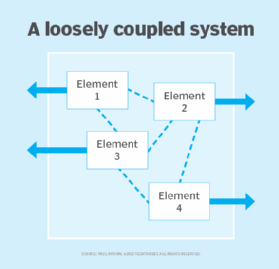loose coupling
What is loose coupling?
Loose coupling is an approach to interconnecting the components in a system, network or software application so that those components, also called elements, depend on each other to the least extent practicable. Coupling refers to the degree of direct knowledge that one element has of another.
Loose coupling reduces the risk that a change made in one component, such as a database or user interface, creates unanticipated changes in other parts. Limiting interconnections can help isolate problems when things go wrong and simplify testing, maintenance and troubleshooting procedures.

How does loose coupling work?
A loosely coupled system can be easily broken down into definable modules, which are equivalent to the previously mentioned components. One way to measure the extent of coupling in a system is to map the maximum number of changes that can occur to those modules without adverse effects.
Examples of such changes include adding or removing modules or renaming, reconfiguring, rearranging or otherwise modifying them. Loosely coupled modules have less dependency on other elements and greater scalability and interoperability than with tightly coupled elements.
In object-oriented programming, dependency injections provide loosely coupled components in a program with the resources they need. Dependency injections provide code that lets the resource know which other resources it should communicate with, where to locate them and how to communicate with them.
Who uses loose coupling configurations?
Most organizations benefit from a loose coupling of their systems unless there is a compelling business reason to tighten their linkages. An example of a situation that requires tight coupling is a food service company, such as a restaurant, that has specific systems dealing with order processing, food supply chains, reservations, food preparation and delivery services.
Data-centric architecture often relies on loosely coupled systems because it requires a high degree of interdependence among components to ensure real-time synchronization. Web services, service-oriented architecture, event-driven architecture and microservices architecture, where different services are decoupled from each other and communicate through application programming interfaces, also make use of loose coupling.
Loose coupling generally simplifies the administration, testing, programming and maintenance activities required of a system. Each element is addressed as a separate entity with minimal concern for a trickle-down impact on other systems.
Loose coupling vs. tight coupling
There are some distinct differences between loosely coupled and tightly coupled systems.

Tightly coupled systems
Tightly coupled systems have their various components linked closely to each other such that a change in one element likely affects the other elements. The overall system and its elements work together to generate an output, rather than having separate and distinct outputs from each component or element. In a tightly coupled system, changes to any one element likely affect the outputs.
In the right environment, such as a data-centric architecture or application, tight coupling might perform better than a loosely coupled architecture. Costs associated with maintaining tightly coupled architectures might be higher than with loose coupling. This is because a change in one component could require changes elsewhere in the system to maintain its overall integrity, requiring more resources and resulting in higher costs.
Loosely coupled systems
There is much less interaction between elements in a loosely coupled system than in a tightly coupled one. Changes to one component are unlikely to affect the others. The nodes in distributed computing systems are an example of loose coupling; they have their own memory and processing power and communicate with other nodes only when necessary.
Loosely coupled systems are often more scalable, flexible and interoperable than tightly coupled ones because changes to one part don't affect the others. This also results in lower costs much of the time.
Advantages of loose coupling
The advantages of loose coupling include the following:
- Lower costs. Administrative, maintenance and other costs tend to be lower for loosely coupled systems because fewer changes are needed across the system, minimizing resource use.
- Improved scalability. Because they're more modular than tightly coupled systems, loosely coupled systems can be easily expanded without disrupting the entire system's architecture. This lets businesses scale their operations fast, while minimizing downtime.
- More flexibility. Loosely coupled systems limit the number of changes needed. This makes it easier for developers to do changes on the fly to software components during development cycles or for system admin to do upgrades and maintenance.
- Better performance. By decoupling certain processes from others, performance can increase because some tasks can run simultaneously, thus leading to faster overall processing times.
- Easier maintenance. With fewer interdependencies among components, fixing bugs becomes much simpler since only specific areas need attention.
Drawbacks of loose coupling
There are drawbacks as well to loose coupling, such as the following:
- Quality and consistency issues. Loose coupling may result in inconsistencies as one component processes requests differently from others. Without some level of intelligence linking the various elements and coordinating the output quality and consistency, results may differ and cause problems.
- Difficulty troubleshooting. Debugging issues become simpler when using loose coupling, but finding source problems can prove difficult because of the lack of direct relationships among the elements.
- Security risks. Data often isn't shared directly through networked devices in a loosely coupled system, so security risks increase if precautions aren't taken to ensure sensitive information is secure in each component of the system.
- Higher development costs. Loosely coupled systems can be more complex and have higher front-end costs, though those can be counterbalanced by lower costs on the back end.
Learn about the basic concepts of software coupling and how to measure dependency complexity.








